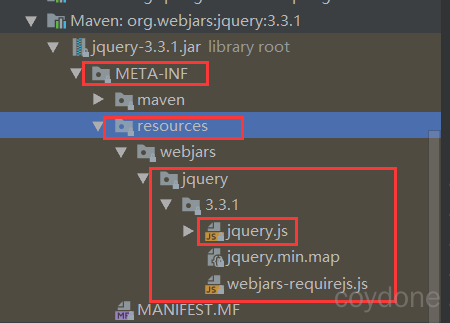静态资源映射规则
在以前的开发中,我们要引入前端资源,比如css,js等文件,我们的main下会有一个webapp,我们以前都是将所有的页面导在这里面的。但是我们现在的pom文件,打包方式是为jar的方式,那么这种方式SpringBoot能不能来给我们写页面呢?当然是可以的,但是SpringBoot对于静态资源放置的位置,是有规定的。
SpringBoot中,SpringMVC的web配置都在 WebMvcAutoConfiguration 这个配置类里面。
我们可以去看看 WebMvcAutoConfigurationAdapter 中有很多配置方法;
有一个方法:addResourceHandlers 添加资源处理。
public void addResourceHandlers(ResourceHandlerRegistry registry) {
if (!this.resourceProperties.isAddMappings()) {
// 已禁用默认资源处理
logger.debug("Default resource handling disabled");
} else {
//缓存控制
Duration cachePeriod = this.resourceProperties.getCache().getPeriod();
CacheControl cacheControl = this.resourceProperties.getCache().getCachecontrol().toHttpCacheControl();
//webjars配置
if (!registry.hasMappingForPattern("/webjars/**")) {
this.customizeResourceHandlerRegistration(registry.addResourceHandler(new String[]{"/webjars/**"}).addResourceLocations(new String[]{"classpath:/META-INF/resources/webjars/"}).setCachePeriod(this.getSeconds(cachePeriod)).setCacheControl(cacheControl));
}
//静态资源配置
String staticPathPattern = this.mvcProperties.getStaticPathPattern();
if (!registry.hasMappingForPattern(staticPathPattern)) {
this.customizeResourceHandlerRegistration(registry.addResourceHandler(new String[]{staticPathPattern}).addResourceLocations(WebMvcAutoConfiguration.getResourceLocations(this.resourceProperties.getStaticLocations())).setCachePeriod(this.getSeconds(cachePeriod)).setCacheControl(cacheControl));
}
}
}
-
所有的
/webjars/**请求, 都需要去classpath:/META-INF/resources/webjars/找对应的资源; -
webjars:以jar包的方式引入静态资源。
webjars
Webjars本质就是以jar包的方式引入我们的静态资源 , 我们以前要导入一个静态资源文件,直接导入即可。
使用SpringBoot需要使用Webjars,我们可以去官网了解。官网:http://www.webjars.org/。
要使用JQuery,我们只要要引入JQuery对应版本的pom依赖即可。
<!--JQuery-->
<dependency>
<groupId>org.webjars</groupId>
<artifactId>jquery</artifactId>
<version>3.3.1</version>
</dependency>
导入完毕,查看webjars目录结构,并访问jquery.js文件。

我们在浏览器中输入localhost:8080/webjars/jquery/3.3.1/jquery.js即可访问到资源。
自定义静态资源映射规则
那我们项目中要是使用自己的静态资源该怎么导入呢?我们看下一行代码;
我们去找staticPathPattern发现第二种映射规则 :/** , 访问当前的项目任意资源,它会去找 ResourceProperties 这个类,我们可以点进去看一下分析:
// 进入方法
public String[] getStaticLocations() {
return this.staticLocations;
}
// 找到对应的值
private String[] staticLocations = CLASSPATH_RESOURCE_LOCATIONS;
// 找到路径
public class ResourceProperties {
private static final String[] CLASSPATH_RESOURCE_LOCATIONS = new String[]{"classpath:/META-INF/resources/", "classpath:/resources/", "classpath:/static/", "classpath:/public/"};
}
ResourceProperties 可以设置和我们静态资源有关的参数;这里面指向了它会去寻找资源的文件夹,即上面数组的内容。
所以得出结论,以下四个目录存放的静态资源可以被我们识别:classpath:类路径即为resources路径下。
# 优先级从高到低
"classpath:/META-INF/resources/"
"classpath:/resources/"
"classpath:/static/"
"classpath:/public/"
"/":当前项目根路径
比如访问"classpath:/static/"下即resources/static/js/jquery.js。我们只需在浏览器中输入localhost:8080/js/jquery.js即可。
自定义静态资源路径
我们也可以自己通过配置文件来指定一下,哪些文件夹是需要我们放静态资源文件的,在application.properties中配置;
spring.resources.static-locations=classpath:/coding/,classpath:/coydone/
一旦自己定义了静态文件夹的路径,原来的自动配置就都会失效了。
首页
在WebMvcAutoConfiguration类中我们可以找到欢迎页配置的代码。
@Bean
public WelcomePageHandlerMapping welcomePageHandlerMapping(ApplicationContext applicationContext, FormattingConversionService mvcConversionService, ResourceUrlProvider mvcResourceUrlProvider) {
......
}
private Optional<Resource> getWelcomePage() {
......
}
private Resource getIndexHtml(String location) {
return this.resourceLoader.getResource(location + "index.html");
}
我们根据上面代码找到WelcomePageHandlerMapping类
WelcomePageHandlerMapping(TemplateAvailabilityProviders templateAvailabilityProviders, ApplicationContext applicationContext, Optional<Resource> welcomePage, String staticPathPattern) {
if (welcomePage.isPresent() && "/**".equals(staticPathPattern)) {
logger.info("Adding welcome page: " + welcomePage.get());//获得欢迎页
this.setRootViewName("forward:index.html");
} else if (this.welcomeTemplateExists(templateAvailabilityProviders, applicationContext)) {
logger.info("Adding welcome page template: index");
this.setRootViewName("index");
}
}
欢迎页,在静态资源文件夹下的所有index.html页面;被"/**"映射。
访问localhost:8080/时,默认就会找/**下所有的index页面,所有我们只需要在能被/**映射的路径下放置index.html页面即可。
网站图标
与其他静态资源一样,Spring Boot在配置的静态内容位置中查找 favicon.ico。如果存在这样的文件,它将自动用作应用程序的favicon。
Spring Boot 2.2.0 以前的版本设置浏览器图标
1、关闭SpringBoot默认图标
#关闭默认图标
spring.mvc.favicon.enabled=false
2、自己放一个图标在静态资源目录下
3、清除浏览器缓存!刷新网页,发现图标已经变成自己的图标了
自 SpringBoot 2.2.0+ 版本之后,原本自定义浏览器图标的方式已经无法使用,设置和原来html设置图标的方式一样。在首页 index.html 中设置。
<link rel="icon" type="image/x-icon" href="favicon.ico"><!--路径根据自己的改-->





评论区